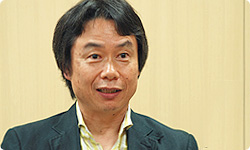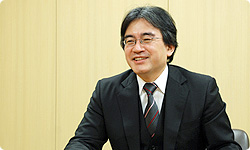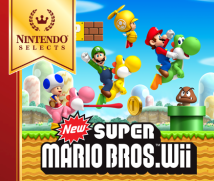5. Allowing Novices To See the Ending Too
Up until now, we’ve spoken about Donkey Kong right through to Super Mario Bros., but if we were to keep going through the history of Super Mario Bros, I don't think we'd ever have enough time to finish the interview! (laughs)
Yes, you’re right! (laughs)
So let’s jump forward in time now to the twentieth anniversary of the release of the Famicom17. In 2004, Nintendo put out the NES Classics series18, including a return for Super Mario Bros. What impression did you have of this? 17 This campaign was held in 2003 to mark twenty years since the release of the Famicom in Japan. One feature of the campaign was a special twentieth anniversary edition of the Game Boy Advance SP. 18 NES Classics were a series of Famicom games re-released for the Game Boy Advance in 2004.
At the time, I had a sense that the number of people who had played games once but who didn’t any longer was steadily growing. But while I understood this in principle, the reality of the situation hadn’t fully struck me. But saying that, of course I’m a gamer and I’m surrounded by people who like games. So then when I heard people talking about this issue at the time the NES Classics series was released, it was really brought home to me: "Ah... So there are this many people out there who remember Mario but who have forgotten all about games!"
That’s why it meant a lot for us personally to have been involved in the twentieth anniversary of the Famicom followed by the twentieth anniversary of Super Mario19. 19 To mark the twentieth anniversary of the original release of Super Mario Bros., a campaign was held in 2005. In addition to Super Mario Bros. being re-released as part of the NES Classics series on 13th September, the date of the original release, the Game Boy Micro was released in Japan.
Yes, I believe that it did. But no matter how far people may drift away from games, their memories of playing Mario are still with them… At that time, Mario had advanced to 3D and we would discuss the fact that there were now two different strands to the Mario series: there was the Mario that had developed in step with consoles as they had become more advanced, and there was also the basic Mario that anyone could play. When I talked about this with Tezuka-san, he said: “Right, if we make another one, it should be a side-scrolling Mario.”
And that became New Super Mario Bros. for DS 20. 20 New Super Mario Bros. was released for Nintendo DS in June 2006 in Europe.
Right. But as you’d expect, looking at it from the perspective of those who were in step with technological developments, one could ask: ”Why are you making a 2D side-scrolling game now?” And then the counter-argument would be: “We can use 3D polygon graphics, but by making a side-scrolling game, won’t we be appealing to a larger number of people?” So we decided to make a Mario that made a fresh start by returning to its core principles. That's why we put "New" in the title.
What were you most conscious of when you were working on New Super Mario Bros. for DS?
As it was a Mario game based on its original principles, of course you had to find the goal if you went to the right. It also couldn’t be over-long, and you had to get the clear sense that you were becoming more skilled if you played it repeatedly.

So “experience points” would build up in your fingers.
Yes, experience would build up. But to release a game for new hardware with only those elements would have been too understated. That's why we decided to put very flashy elements in the game.
Are you referring to the giant Mario ?
That’s right. If you include that enormous Mario, the rest of the game can be as old-fashioned as you like.
After actually making the game, do you have any regrets or feelings that you wish you’d done things differently?
If I had to point out one aspect, I’d say that the difficulty level was a little…
While you succeeded in coming up with a Mario title that anyone could play, for those players who were seeking a bit more of a challenge, it may have been a touch too easy.
As you can imagine, no matter how hard you try, it just isn’t possible to settle on a difficulty level that will satisfy everyone ranging from people who haven’t played a game in years right through to players who know all the Mario games inside out. You have to focus it on either one or the other.
I like to describe the series of action games that you and your team come up with, most famously Mario, as being "sports tournament games”. What I mean is, by pushing yourself harder and harder, you make progress, and then just when you have the goal in sight, you slip up. Then a voice seems to come from above that tells you: "Right! Give it another try!” Then you try again, and fail yet again. But by doing that, and failing again and again, you will steadily build up experience and as a result, when you do succeed, the feeling of satisfaction is incredible. That’s why I think they’re reminiscent of a sports tournament.
That’s why we even discussed releasing an enhanced version of New Super Mario Bros., for those people who wanted to play a Mario which demanded more skills. With the Wii version of New Super Mario Bros. this time round, its biggest single defining feature lies there. We didn't just want first-time players to enjoy it; we wanted to make a new Mario game that players looking for a stiffer challenge would be able to relish.
How did you try to resolve the difficult issue of making a game that was able to please both camps?
Firstly, if you play Mario and just can’t manage to finish a level, you feel like crying, don’t you?
Absolutely! You feel like crying! (laughs)
There’s always a basic reason why you can’t clear a level: either it’s because the game is really difficult, or it’s because you don’t understand the game properly. For instance, even though you could use a lift and bounce easily to the next stage, you go out of your way to choose a tricky route and that means no matter how many times you try it, you fail.
So you’ve ramped up the difficulty level yourself by not choosing the correct route.
Yes, that's right. It’s at times like that when watching a skilled player will make you realise: “So that’s what you have to do!” Then you can do it correctly yourself. I thought it would be great if you were able to do that in your own home, which is why we devised the Super Guide.
Could you explain what the Super Guide is?
To help you progress through the level, Luigi shows you the correct path .
So it’s not Mario, it’s Luigi. But there are going to be those people who even when they watch the Super Guide will feel like crying, thinking: "But I can't do that!"

That’s why the Super Guide won’t only show you the correct strategy, it will also allow you to provisionally clear the course. It will present you with the option to skip that course and move on to the next one.
So in other words, by using the Super Guide, you could get right through to the end.
Well, since you’ve purchased it, it’s surely better to be able to see the ending.
But isn’t there a risk that by allowing that, the essence of playing an action game will somehow be lost? I said it a little earlier, but it’s precisely by pushing yourself a little harder, and by failing again and again, that the feeling of achievement you get when you succeed grows.
We’ve included a number of elements in the game with that in mind. Now, I’m sure you’ve had times when there’s been one particular place on a level that you just can’t get past, no matter how hard you try.
Those are the places that will really have you on the verge of tears!
There are times when even if you watch the Super Guide and understand how you should do it, you still can’t manage it yourself. At times like that, you can use the Super Guide to get past the tough part then play yourself .
So part-way through the Super Guide, you can take over just like that?
Once it’s gone past the tricky part, you can press the Pause Button and change the player back to yourself. The player will be Luigi, but his jumping ability21 is the same as Mario’s. 21 In Super Mario Bros. 2, released for the Famicom Disk System in June 1986 in Japan, Luigi could jump higher than Mario. In New Super Mario Bros. Wii, his jumping ability is the same as Mario’s.
Novices will be happy about this feature.
But while it was my idea to include this feature, as a gamer, I would feel intensely irritated if you were asked, “Do you want to see the Super Guide?,” right from the start of the game.
You wouldn’t be able to allow that? (laughs)
There’s no way I could ever allow that!
You think “Am I going to view the Super Guide without even playing the game once!?” (laughs)
Exactly! (laughs)
